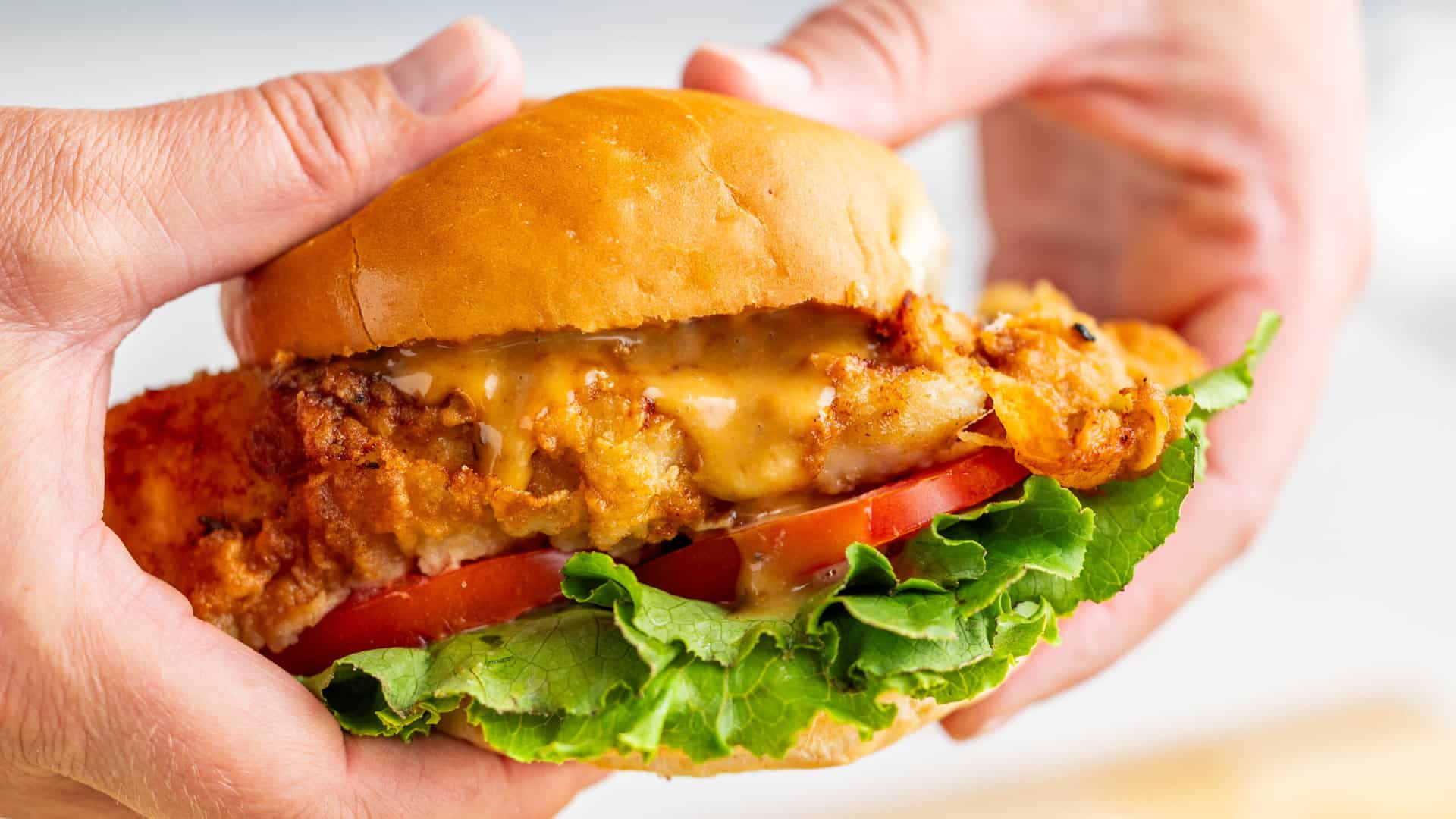On this publish, you’ll be taught to create a fundamental sourdough starter from scratch at house, following a easy step-by-step course of. All you’ll require are flour, water, and a touch of persistence. Quickly sufficient, you’ll have a vigorous, energetic starter good to go!

Desk of Contents
What’s Sourdough Starter?
First, let’s make “sourdough starter” intimidating. Image it as a dwelling combo of flour and water, bustling with wild yeast and helpful micro organism.
This mix is your secret weapon in bread making, giving your loaves of lovely rise and unimaginable taste.
Consider sourdough starter as each the key to and core of sourdough bread. It replaces the necessity for business yeast in your baking. With out it, we wouldn’t have the scrumptious sourdough bread we love.
What’s Sourdough Starter Made Of?
What’s wonderful is {that a} sourdough starter is extremely easy. It’s simply flour and water. That’s it!
Flour: Acts because the food supply. It offers the sugars and vitamins vital for the yeast and micro organism to thrive.
Water: Hydrates the flour, enabling the enzymes to interrupt down the starches into sugars that the yeast and micro organism can eat.
When flour and water are mixed and left in a conducive setting, they start to draw yeast and micro organism current within the air and on the grains of the flour. As they eat the sugars from the flour, these microorganisms produce carbon dioxide fuel and natural acids. This leads to a bubbly combination that has a tangy aroma – the hallmark traits of a sourdough starter.
What’s Sourdough Starter For?
Let’s discuss why sourdough starter is your finest good friend in bread baking.
It’s the famous person that leavens your dough, giving it that great rise. Because of the carbon dioxide produced throughout bread fermentation, air bubbles seem, giving us ethereal and chewy loaves.
Nevertheless it’s not nearly leavening; starter can also be answerable for the distinctive taste and texture that outline sourdough bread. The natural acids produced by the micro organism give sourdough its signature tangy taste.
Widespread Forms of Sourdough Starter
Sourdough starters come in several flavors and types, usually influenced by the kind of flour used or regional traditions. Widespread sourdough starter sorts embrace:
| Kind of Starter | Elements | Style |
|---|---|---|
| Conventional Sourdough Starter | all-purpose or bread flour + water | pleasantly tangy or bitter, barely candy |
| Rye Sourdough Starter | rye flour + water | earthy, nutty, milder tangyness in comparison with conventional sourdough |
| Complete Wheat Sourdough Starter | wheat flour + water | barely candy, milder tangy taste in comparison with conventional sourdough, much less earthy than rye sourdough |
| recipe” goal=”_blank” data-type=”hyperlink” data-id=”https://www.kingarthurbaking.com/recipes/gluten-free-sourdough-starter-recipe” rel=”noreferrer noopener”>Gluten-Free Sourdough Starter | brown rice flour (or different GF flours) + water | clear and lightweight, gentle sweetness, not earthy or nutty |

What to Know Earlier than You Begin
Sourdough starter creation requires persistence, particularly within the preliminary days when it’s possible you’ll not see a lot exercise. It’s important to belief the method and proceed with every day feedings.
How Lengthy
How lengthy ought to a sourdough starter take to make? Making a sourdough starter utilizing the normal methodology can take about 5 to 7 days. Some strategies can take longer, however we’re solely speaking concerning the fundamental methodology right now.
Issue
Do you might want to be an skilled? Nope!
In case you have prior expertise with bread making or working with yeast, it’s possible you’ll discover the method simpler. Nevertheless, rookies also can efficiently create a starter. With the suitable steering and persistence, anybody can efficiently create a sourdough starter
Sustaining a constant feeding schedule is essential for a profitable starter. It requires every day feeding for the primary a number of days, which could be a bit demanding. As soon as the starter is established, the upkeep turns into much less frequent.
Flour
Use good-quality flour. If potential, go for natural flour which is free from components that may intervene with fermentation.
To raise your starter, use complete wheat or rye flour. Complete wheat flour is wealthy in vitamins and retains most elements of the grain. This not solely offers an ideal supply of meals for the wild yeast but in addition leads to a extra energetic and strong starter. Rye flour comprises a excessive mineral content material, fostering a conducive setting for fermentation. Moreover, its distinctive taste can add a pleasant complexity to your sourdough.
In case you don’t have entry to those flours, all goal flour nonetheless works effectively! It’s a favourite amongst many bakers, too. In reality, you’ll be able to even combine flours. Simply know that there can be variations in exercise because of this. Totally different flours can react in several methods.
Maintaining a tally of your starter’s conduct is essential to making sure it stays wholesome for the lengthy haul.
Water
As little chlorine in water as potential is important. Chlorinated water can inhibit the expansion of the helpful microorganisms wanted for fermentation. Go for filtered or bottled water if you happen to can.
The mineral content material within the water also can play a refined function within the style and exercise of your starter. Some bakers even go the additional mile to make use of spring water, valuing its pure mineral composition.
Gear
The sort of container you utilize to accommodate your starter can affect its well being.
Use a clear, non-reactive container like glass or plastic, and keep away from metallic containers. Glass jars are most well-liked as they’re non-reactive. Guarantee they’re clear and dry earlier than transferring your starter. Each from time to time, it’s additionally a good suggestion to sterilize the jar to kill any lurking pathogens.
Likewise, all the time use clear utensils when dealing with your starter.
Lastly, don’t use a small jar. Keep in mind that your starter will develop, so a medium to giant jar ought to do.
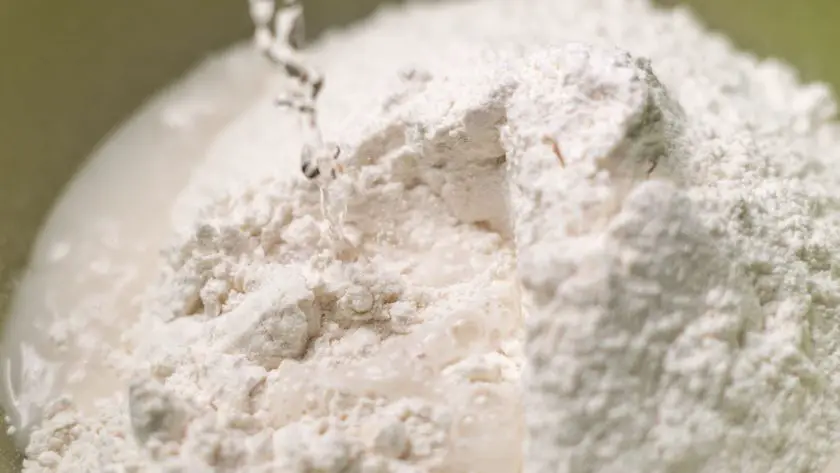
The Final Sourdough Starter Recipe + Schedule
Right here’s an in depth information to crafting your personal sourdough starter from scratch, together with an in depth schedule for one of the best outcomes:
Elements
- 1 cup flour (complete wheat or rye)
- 1/2 cup lukewarm water (filtered, non-chlorinated)
Instruments
- wood spoon
- clear huge bowl
- glass jar with lid
Step by Step Process and Full Timeline
Having a schedule can enhance your possibilities of success, particularly if you happen to’re new to sourdough starter-making.
Day 1
This stage is the simplest. Simply mix the substances, combine effectively, switch to your jar or container, and wait.
- In a clear glass or plastic container, mix 1/2 cup of flour and 1/4 cup of lukewarm water.
- Stir the combination effectively till all of the flour is hydrated (no dry pockets). Stirring totally ensures even hydration and introduces aeration, which is essential for yeast exercise. After mixing, the consistency ought to resemble a thick paste.
- Switch your combination to your jar.
- Cowl the container loosely with a clear kitchen towel or plastic wrap.
- Enable it to take a seat at room temperature (round 70-75°F or 21-24°C) for twenty-four hours. Put your starter in a heat (not scorching!) spot in your home, if you happen to dwell someplace chilly.
Day 2
That is while you begin feeding, which is significant for the expansion and well being of your starter.
- Test your combination. You would possibly see some bubbles and get a whiff of a dough odor, indicating exercise. It is a good signal. If there are little to no bubbles, that’s okay, too. They’ll take time to be apparent in dimension and quantity.
- Discard half of the combination, about 1/2 cup. This is a crucial step, in any other case you’ll have an excessive amount of starter.
- Add one other 1/2 cup of flour and 1/4 cup of lukewarm water to the remaining combination.
- Stir effectively to keep up an excellent consistency and introduce aeration.
- Cowl, and let it sit for one more 24 hours.
Day 3
- By now, your combination needs to be displaying extra bubbles and have a barely tangy odor.
- At this level (principally when there’s exercise), I like to recommend to switch the starter right into a clear glass jar the place you wish to home it indefinitely so long as you utilize it.
- Discard half of the combination once more.
- Add 1/2 cup of flour and 1/4 cup of lukewarm water, stirring totally.
- Cowl and let it sit for one more 24 hours.
Days 4 and 5
- Repeat the feeding course of (discarding half, including flour, and water) twice every day, roughly each 12 hours.
- Your starter ought to grow to be extra energetic with extra bubbles and a nice bitter aroma.
Day 6
Your sourdough starter ought to now have loads of bubbles (each huge and small), have a pleasantly tangy aroma, and have doubled in quantity in comparison with Day 1.
Now you can think about it prepared to make use of in sourdough recipes.
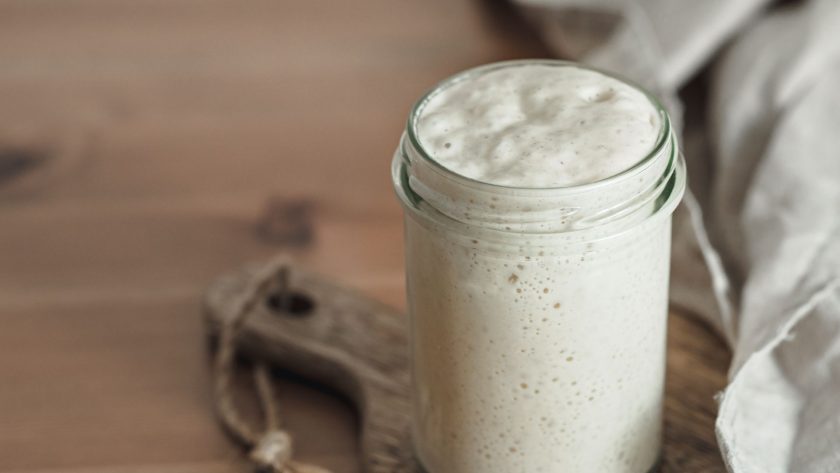
Sustaining and Feeding Sourdough Starter
Sustaining a sourdough starter is somewhat bit like caring for a pet. Lively mature starters stored in room temperature require common consideration and care to remain alive and thrive.
Listed below are some fundamental steps to sustaining your starter every day:
- Have a daily feeding schedule. It helps to set a reminder in your cellphone so that you received’t neglect!
- Take away and discard half of your starter (this can be utilized in different recipes or shared with pals).
- Add equal elements of flour and water (usually 1 cup of flour to 1/2 cup of water) to the remaining starter. Combine till easy.
- Cowl loosely and let it sit at room temperature.
Word that that is just for room temperature starters. In case you’re storing your starter within the fridge, a once-a-week feeding schedule is ample. For longer baking intervals, think about drying some starter flakes as backup. Rehydrate and feed them while you’re able to bake once more.
When is Sourdough Starter Prepared
A starter that has been fed recurrently and correctly for not less than every week is taken into account mature. By this level, has a steady microbial group and is extra more likely to be prepared for baking.
Indicators of a Wholesome Starter
Listed below are some tell-tale indicators that your starter is energetic, wholesome, and able to use in recipes:
- Bubbles: A bubbly floor is not any trigger for fear. Meaning the yeast and micro organism are doing their factor and fermenting away!
- Aroma: If it’s obtained a tangy, kinda bitter odor, you’re heading in the right direction. That’s the signature scent of a strong starter.
- Doubling in Quantity: In case your starter grows twice its dimension in simply 4-6 hours after feeding you then’ve obtained your self a powerhouse starter!
- Float Take a look at: It is a well-liked methodology amongst bakers. Take a small spoonful of your starter and drop it gently right into a glass of water. If it floats, it’s an indication that your starter is stuffed with fuel and prepared for use in your bread recipe. If it sinks, it would want extra time or one other feeding.
- Predictable Rising and Falling: When you’ve been feeding your starter recurrently, you must discover a predictable sample of when it rises after feeding and when it begins to fall or deflate. When it reaches its peak top and simply begins to fall, it’s usually at its prime for baking.
- Consistency: The starter ought to have a thick, however pourable consistency, very similar to a thick pancake batter.
All this stated, some flours could be a bit difficult and would possibly make your sourdough starter take its candy time. I’ve heard starters taking an entire 2 weeks earlier than they’re good to go. So, the trick is to only keep watch over it and be looking out for indicators of contamination.

Ideas for a Profitable Sourdough Starter
Feeding
- At all times guarantee it’s fed recurrently. Preserve a constant feeding schedule and temperature (round 70-75°F or 21-24°C) to encourage yeast progress.
- Keep in mind that making a sourdough starter takes persistence and apply. The longer you keep and feed your starter, the extra advanced and flavorful it can grow to be.
- Skipping a few isn’t the top of your starter. It would simply look underfed or flat, so simply feed it once more to get it proper once more. And in case your starter’s been out of motion for some time, it would want a few feeds to bounce again. No worries if outcomes usually are not speedy.
- Keep in mind to discard earlier than feeding, in any other case you may be overwhelmed by an excessive amount of starter. Feed your starter each time you bake with it or discard it.
Storage
- In case you plan on baking usually, retailer your starter on the counter and feed it every day.
- In case you plan to bake often, retailer your starter within the fridge and feed it as soon as every week. You’ll be able to feed it both straight out of the fridge or after it reaches room temperature.
- Considering of baking for an prolonged time? It’s a good suggestion to dry out some starter flakes and preserve them helpful. Simply add water and provides them a feed while you’re all set to bake once more.
- At all times go for a clear vessel while you’re transferring or storing your starter. Glass jars are one of the best since they don’t mess along with your starter’s vibes.
- Your jar needs to be roomy. Keep in mind, the starter grows – so assume double its present quantity.
Widespread Sourdough Starter Errors (and Options)
Like all journey, there is perhaps just a few bumps alongside the way in which. Let’s chat concerning the typical sourdough troubles newcomers face and, extra importantly, how one can avoid them.
Overfeeding Your Starter
It’s like giving an excessive amount of sweet to a child – it’s simply not helpful in the long term. In case you feed your starter too usually, you would possibly dilute the focus of yeast and micro organism, making it much less energetic.
Tip: Persist with a daily feeding schedule. In case you’re conserving it on the counter, as soon as a day ought to do. Within the fridge? As soon as every week is ideal.
Not Feeding It Sufficient
On the flip aspect, in case your starter develops hooch (boozy liquid layer) on high, or if it will get watery and develops a nasty odor, it’s most likely hungry. An underfed starter can result in a sluggish fermentation course of.
Tip: Don’t neglect to feed your starter! Preserve an eye fixed out for any adjustments in aroma or look – they’re often your starter’s approach of telling you it’s feeding time.
Consistency Points
A well-maintained sourdough starter ought to have a consistency that’s considerably like a thick pancake batter. Nevertheless, there are occasions while you would possibly discover your starter straying from this preferrred consistency.
In case your starter feels extra like a dough than a batter, it’s too thick. This may be on account of utilizing a flour sort that absorbs extra water or a change in ambient temperature. A starter that’s too runny won’t be capable to lure sufficient fuel, which may result in breads that don’t rise effectively.
Tip: If the consistency turns into too thick or skinny, regulate with somewhat water or flour throughout feedings. In case your starter develops an disagreeable odor, pink or orange discoloration, or mould, throw it away and begin over.
Storing Your Starter Flawed
Sourdough starter, whereas hardy, does have its preferences and dislikes, particularly in the case of its dwelling quarters.
The very last thing you need is mould creeping into your starter. In case your starter isn’t saved accurately, you’re basically rolling out the welcome mat for mould.
A darkish or orange liquid (completely different from the clear or grayish hooch) or a extremely off odor (completely different from the same old tangy aroma of sourdough) can point out mould.
Tip: At all times use a clear jar when transferring your starter, and if you happen to see any indicators of mould, it’s safer to begin contemporary. Use clear utensils when dealing with your starter.
Learn how to Use Sourdough Starter
Baking with a sourdough starter doesn’t simply introduce unbelievable taste and texture to your bread, it additionally brings with it the satisfaction of crafting one thing really artisan.
Right here’s the way to successfully use your starter and combine it into your favourite recipes:
Primary Sourdough Bread Recipe
Elements
- 1 cup energetic sourdough starter
- 1 1/2 cups lukewarm water
- 4 cups bread flour
- 1 1/2 teaspoons salt
Learn how to Make Sourdough Bread
- Mix the starter, water, and three cups of the flour. Combine till easy.
- Add the remaining flour and salt, kneading till the dough is easy and elastic (about 10 minutes).
- Place the dough in a frivolously greased bowl, cowl, and let it rise till it has doubled in dimension (this could take anyplace from 4 to eight hours, relying in your starter’s efficiency and ambient temperature).
- Gently form the dough right into a spherical or oval loaf. Let it rise once more for 1 to 2 hours.
- Preheat your oven to 425°F (220°C). Make just a few slashes on high of your loaf to permit it to develop whereas baking.
- Bake for 25 to half-hour, or till the crust is golden brown and sounds hole when tapped.
Extra Sourdough Starter Makes use of
- Adjusting for Style: Sourdough is of course tangy, however you’ll be able to regulate the sourness stage. For a milder taste, use the starter earlier throughout its peak. For a tangier loaf, prolong the rise time or use a extra mature (longer since feeding) starter.
- Incorporating into Different Recipes: Your sourdough starter isn’t restricted to only bread! Think about including it to pancakes, muffins, crackers, and even pizza dough. When doing so, keep in mind to regulate the quantity of liquid and flour in your recipe to account for the hydration of the starter.
- Discarding Sourdough Starter: Common feedings of your starter require you to discard a few of it to keep up a manageable amount and preserve it wholesome. However “discard” doesn’t imply waste! You should utilize the sourdough discard for a lot of recipes as effectively. If you end up with an excessive amount of discard, think about lowering how usually you feed or the quantity you retain. You’ll be able to compost discard when you’ve got an excessive amount of or no time to make use of it.
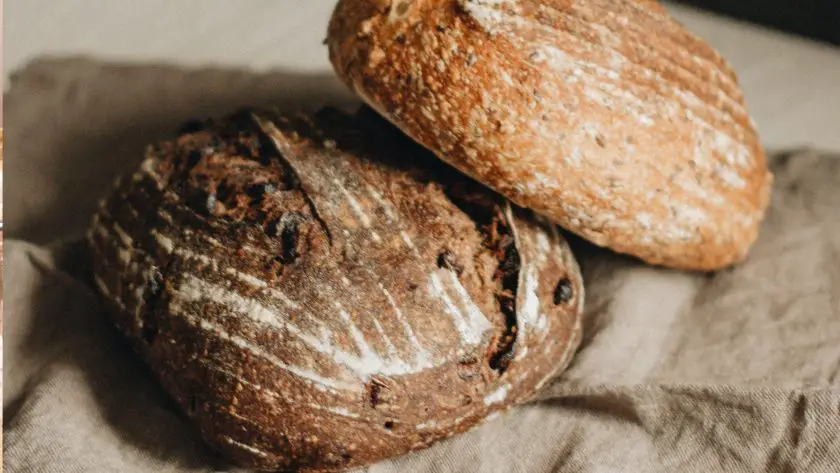
Learn how to Retailer Sourdough Starter
Not but within the temper to bake? That’s okay. You’ll be able to retailer your sourdough starter for future use. Let’s get into the way to finest retailer your starter to make sure it stays alive, kicking, and prepared in your subsequent baking enterprise.
Refrigeration (Chilly Storage)
- When to Go for It: This methodology is a go-to if you happen to’re not within the temper for every day baking however nonetheless wish to preserve your starter with out a lot fuss.
- Learn how to Do It: Give your starter a very good feed throughout the final day. Switch it to a glass jar with a loosely becoming lid. You could possibly additionally go for plastic wrap, however guarantee some area for the gases. Pop it into the fridge. Make it a ritual to feed your chilled starter weekly. You’ll be able to technically feed the starter as-is out of the fridge, but when your home is just too chilly, you’ll be able to look ahead to the starter to heat up a bit.
Room Temperature Storage
- When to Go for It: In case you’re the type who’s baking fairly usually, like each couple of days.
- Learn how to Do It: Retailer that starter in a glass jar. However right here’s a tip: cowl it with a material and safe it with a rubber band. Feed it every day – it’s hungry extra usually at room temp! Discover a cozy spot at constant room temperature, away from any pesky daylight.
The Lengthy Sport (Lengthy-Time period Storage)
- When to Go for It: Say you’re taking a baking hiatus.
- Learn how to Do It: Dry it out. Unfold the starter skinny on some parchment and let it air out till dr. Crumble it up, retailer it in an hermetic container, and also you’re golden. When the baking bug bites once more, simply add water, throw in some flour, and convey your starter again to life.
Why Sourdough Starter?
When you style sourdough bread and perceive its well being advantages, you’ll marvel why you didn’t begin sooner. Sourdough starter is your gateway to all these benefits.
Sourdough Starter vs Yeast
Sourdough starter brings a mess of advantages to the world of bread baking, surpassing the capabilities of business yeast.
- Sourdough starter harnesses wild yeast and lactic acid micro organism and this pure fermentation course of leads to bread that has a singular, advanced taste profile. This style is troublesome to copy with business yeast.
- The lengthy fermentation course of in sourdough bread breaks down gluten and phytic acid, making the bread extra digestible for many individuals. Some people with gluten sensitivities discover that they will tolerate sourdough bread higher than bread made with business yeast.
- Sourdough bread tends to remain contemporary longer than bread made with business yeast.
- Sourdough bread has a milder impression on blood sugar ranges, in comparison with breads utilizing business yeast.
- Sourdough starter can be utilized not just for bread but in addition for a variety of baked items, together with pancakes, waffles, muffins, and extra.
Why Make Sourdough Starter?
When you may have an energetic sourdough starter, you don’t must depend on store-bought business yeast. Crafting your starter shouldn’t be solely satisfying but in addition budget-friendly. Sourdough starter, when cared for, can final for years, and a few starters have even been handed down by means of generations.
You get to tailor your starter to attain your most well-liked taste profile. Not simply that, you may have full management over the standard of the flour and water you utilize, which you’ll be able to’t do with business leaveners.
The flexibility of your personal sourdough starter additionally allows you to make so many baked items, not simply bread. It’s a precious addition to your baking repertoire.
Bonus, making sourdough starter isn’t as laborious as you would possibly assume and it’s so rewarding!
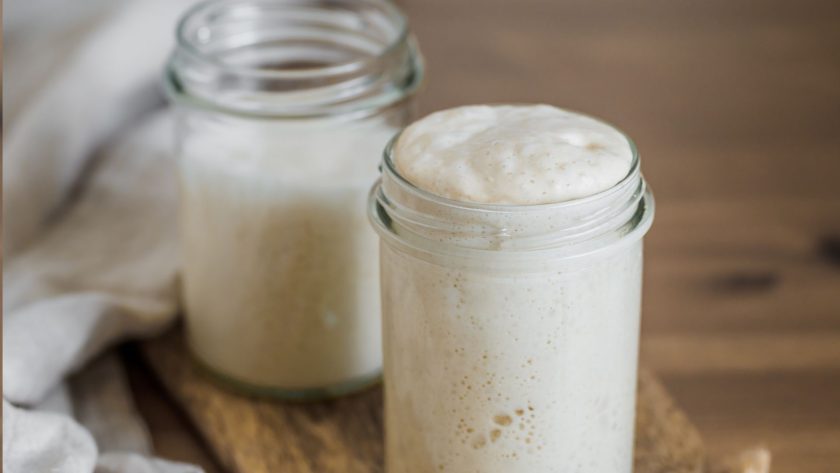
Embracing the Sourdough Expertise
Beginning your personal sourdough journey might sound daunting at first, however like all issues, apply and persistence go a great distance. The distinctive aroma, texture, and style of a contemporary sourdough loaf are (on this baker’s humble opinion) incomparable and price each effort.
So, whether or not you’re a seasoned baker or a beginner, dive in! Experiment, be taught out of your errors, and benefit from the unimaginable journey that’s sourdough baking. Apply what you’ve realized to this straightforward sourdough bread for rookies recipe!
Keep in mind, sourdough isn’t nearly following steps. It’s about embracing the nuances and understanding the rhythm of your starter. Some days it would shock you, different days it would check your persistence, however that’s all a part of the appeal.
Pleased baking!
FAQs
How is sourdough starter made?
By combining equal elements flour and water and letting it ferment at room temperature, the combination turns into an energetic sourdough starter.
Can I make sourdough starter with out discarding?
Sure, but it surely’s not really useful. Once you don’t discard, the amount of the starter will enhance quickly with every feeding, requiring extra flour and water to keep up and ultimately resulting in an impractically giant quantity.
Can you utilize any sort of flour to make a sourdough starter?
Sure, you need to use varied forms of flour to make a sourdough starter, however some flours work higher than others.
Is it price making your personal sourdough starter?
In case you love the concept of cultivating your personal wild yeast, take pleasure in hands-on kitchen tasks, and recognize the distinctive style of sourdough, it’s positively price making your personal starter. Nevertheless, if you happen to’re on the lookout for a fast and easy baking expertise with out the dedication of upkeep, it won’t be the suitable selection for you.

- 1 cup flour (complete wheat or rye)
- 1/2 cup lukewarm water (filtered, non-chlorinated)
Instruments
- wood spoon
- clear huge bowl
- glass jar with lid
Day 1
- In a clear glass or plastic container, mix 1/2 cup of flour and 1/4 cup of lukewarm water.
- Stir the combination effectively till all of the flour is hydrated (no dry pockets). Stirring totally ensures even hydration and introduces aeration, which is essential for yeast exercise. After mixing, the consistency ought to resemble a thick paste.
- Switch your combination to your jar.
- Cowl the container loosely with a clear kitchen towel or plastic wrap.
- Enable it to take a seat at room temperature (round 70-75°F or 21-24°C) for twenty-four hours. Put your starter in a heat (not scorching!) spot in your home, if you happen to dwell someplace chilly.
Day 2
- Test your combination. You would possibly see some bubbles and get a whiff of a dough odor, indicating exercise. It is a good signal. If there are little to no bubbles, that’s okay, too. They’ll take time to be apparent in dimension and quantity.
- Discard half of the combination, about 1/2 cup. This is a crucial step, in any other case you’ll have an excessive amount of starter.
- Add one other 1/2 cup of flour and 1/4 cup of lukewarm water to the remaining combination.
- Stir effectively to keep up an excellent consistency and introduce aeration.
- Cowl, and let it sit for one more 24 hours.
Day 3
- By now, your combination needs to be displaying extra bubbles and have a barely tangy odor.
- At this level (principally when there’s exercise), I like to recommend to switch the starter right into a clear glass jar the place you wish to home it indefinitely so long as you utilize it.
- Discard half of the combination once more.
- Add 1/2 cup of flour and 1/4 cup of lukewarm water, stirring totally.
- Cowl and let it sit for one more 24 hours.
Days 4 and 5
- Repeat the feeding course of (discarding half, including flour, and water) twice every day, roughly each 12 hours.
- Your starter ought to grow to be extra energetic with extra bubbles and a nice bitter aroma.
Day 6
- Your sourdough starter ought to now have loads of bubbles (each huge and small), have a pleasantly tangy aroma, and have doubled in quantity in comparison with Day 1.
- Now you can think about it prepared to make use of in sourdough recipes.
Key phrases: sourdough starter recipe







